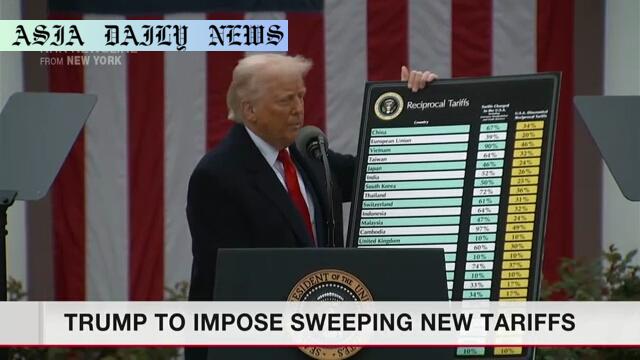Tariffs – US President Trump imposes tariffs ensuring a baseline of 10% on imports globally, escalating trade policies with key countries.

Trump Implements Steep Tariffs Across the Globe
US President Donald Trump has once again made waves in global economics with his application of new tariffs on imports worldwide. As part of a broader strategy coined “Make America Wealthy Again,” the president has decided to impose a sweeping minimum tariff rate of 10% on goods from all trading partners. Additionally, several countries, including key allies and major trading nations, face significantly higher levies. This announcement underscores a marked shift in the United States’ approach to international trade, aiming to recalibrate trading partnerships in what is described as a ‘reciprocal’ manner.
Japan, a long-standing ally and trading partner to the US, is saddled with a 24% tariff, manifesting serious concerns among economists and analysts about the ripple effects of such actions. China’s burden is even steeper, with 34% tariffs, while India will see 26% and the European Union 20% on their goods. These measures are slated to take effect in two phases: the baseline 10% on all countries from Saturday following the official announcement and the enhanced reciprocal tariffs for select countries from April 9. While the administration promises fairness through reciprocal measures, the methods for calculating such rates remain ambiguous, leaving critics questioning the efficacy and fairness of this policy.
The Context Behind Tariff Decisions
Tariffs have long been used as an economic tool to mend trade deficits, protect domestic industries, and even as political leverage. However, Trump’s strategic execution of these tariffs indicates a resurgence of protectionist policies, deviating sharply from the liberal trade norms upheld by previous administrations. The proposed tariffs appear to draw comparisons between what the US perceives as exploitation by trading partners and the steps taken to remedy it. According to President Trump, the concept of a reciprocal tariff ensures ‘trade fairness’: mimic any tariff an American product faces abroad and apply it equally to the corresponding country’s exports to the US.
In theory, such measures might encourage negotiations to lower barriers and resolve imbalances. However, many international analysts argue that this approach could further entrench protectionist behaviors globally, potentially sparking economic retaliation. It is equally critical to note that several industries, including automotive manufacturing, electronics, and agriculture, heavily reliant on imports, could be inadvertently impacted by these sweeping tariffs. Business leaders and policymakers alike are increasingly concerned about the downstream implications for the American consumer, who may ultimately face higher prices on a wide range of goods.
Global Reactions and Potential Outcomes
The international response to the announced tariffs has been mixed, with voices ranging from strong criticism to measured caution. Japan, subjected to a hefty 24%, expressed disappointment but refrained from immediate retaliation, opting instead for dialogue. Meanwhile, the European Union has conveyed its concerns and considered options for countermeasures, maintaining its priority to balance free trade with fairness. China’s situation is particularly emblematic of the broader tensions, given its strategic role in global supply chains and its historically contentious trade relationship with the US.
Notably, the announcement of reciprocal tariffs has reignited discussions on the ongoing US-China trade war, which has seen similar strategies concerning goods like steel and technology products. Economists are scrambling to ascertain the long-term implications for global markets, particularly in Asia and Europe. A recurring theme is that the economic consequences of trade wars rarely confine themselves to the parties directly involved. Instead, they often have far-reaching impacts, altering supply chains, shifting production hubs, and increasing consumer prices universally.
Whether or not these tariffs achieve their intended mandate of securing fairer trade terms for the United States remains to be seen. However, these actions undeniably mark a pivotal moment in global trade policy, potentially heralding a new era of economic nationalism. As April draws closer, focus will remain on bilateral talks, international diplomacy, and market reactions.
Commentary
Commentary on the Implications of Tariffs
It is difficult to overstate the significance of President Trump’s tariffs in shaping global economic relations. These measures represent an audacious effort to redress trade imbalances and protect domestic industries, yet their implications are far from straightforward. On one hand, ensuring reciprocal trade fairness is a concept that resonates well with national sentiments, particularly in countries like the United States that have often claimed to bear the brunt of unfair trade practices. However, on the other hand, the execution of these policies brings forth challenges that could offset any intended economic gains.
One pressing concern is the potential for countries like Japan and major trading blocs like the European Union to retaliate, inflating the specter of a full-blown global trade war. Historically, such escalations have proven detrimental to all countries involved, significantly dampening global growth. At the center of this debate lies the American consumer, who might face rising costs on everyday goods. Industries reliant on global supply chains, such as electronics and automotive manufacturing, will almost certainly bear the impact, adding to the economic burden domestically.
Furthermore, the methodology of calculating such ‘reciprocal’ tariffs raises eyebrows. Without transparency, critics question whether this policy risks alienating allies while aggravating adversaries. International diplomacy has often been a delicate balance, and unilateral actions like these may inadvertently hamper collaborative efforts on trade, climate, and security.
In conclusion, while President Trump’s tariff policies set out with the noble mission of protecting American interests, the broader implications warrant continuous scrutiny. It’s imperative to strike a balance between protectionism and globalization to ensure that short-term economic gains do not come at the cost of enduring financial and diplomatic challenges. Only time will tell if this bold strategy leads to the prosperous and self-reliant future envisioned by its architects or if it triggers an era of heightened global economic uncertainty.


